Porcelain Insulator News
by Elton Gish
Reprinted from "Crown Jewels of the Wire", July 1993, page 14
What I consider to be the unipart find of the decade is an odd Fred Locke
pin-type that was recently reported. I am admittedly biased when it comes to
Fred Locke porcelain, but surely you will agree that this is a great new
discovery!
Bob Berry (NIA#1203) managed to acquire this fine jewel at an eastern show
last fall. I have assigned it U-339B, since it obviously fits alongside the
one-of-a-kind U-339A. The U-339A was dug at the Victor dump back in the 1970's.
It has the 1-8 incuse marking on the top of the 1-3/4" loop and a dark tan
glaze.
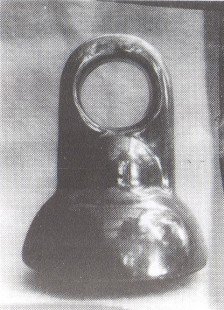
U-339A |
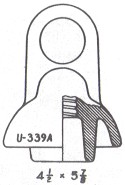 |
Bob's new insulator, U-339B, is a smaller version of U-339A. It has a very
pretty rusty-tan glaze and a 3/4" hole in the crown. There is even the
number "3/4" neatly scratched to the right of the hole. On the flat
surface on top of the insulator is a very strong 1-2 marking. [For details of
the Fred Locke markings and U-number drawings for porcelain unipart styles,
refer to Jack Tod's book, Porcelain Insulators Guide Book.] U-339B was
discovered just after I published the "1992 U-Chart Supplement" (still
available for $1 plus long SASE), so it will be added to the next supplement.
I
guess that we will never know the reason for the hole in these two styles. The
Pittsburg U-339 picked up on the idea many years later, and well after Locke
dropped the idea (apparently, this was soon after Fred left the company in
1904). Our best guess is that these were used as "slack wire"
insulators, where the cable was threaded through the hole in the insulators, and
allowed to hang with a small amount of slack. This would allow the cable to
expand and contract with temperature changes. I suspect that these insulators
were used indoors at an industrial facility, where the heavy cable was merely
supported, rather than held firmly in place with a tie-wire. These insulators
would not be suitable for standard outdoor use, where the cable would be free to
swing in the wind, resulting in damage to both the cable and the insulator. With
the recent discovery of the Etheridge designs, U-376C and U-376D, at various
steel mills in Pennsylvania (which were used to support heavy electrical cables
inside the buildings), I suspect that the slack wire insulator design may have
been superseded by the stronger Etheridge designs. These stronger cable top
insulators, which were probably introduced circa 1904, would adjust to changes in cable expansion by allowing the
insulator to turn slightly on the unthreaded tubular pin.
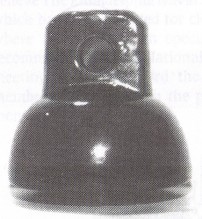
U-339B |
 |
While doing research
for my upcoming book about Fred Locke, I came across a photograph that showed
Fred Locke himself standing in front of an outdoor insulator display booth, at
an electrical trade show. The year was probably 1904. On the bottom shelf at the
front of the booth, was U-339A. and next to that insulator was U-339B! I found
this photograph a few months before Bob reported the U-339B specimen. Many other
insulators were present in the photograph, some of which have never been
found. Unfortunately, you will have to wait until my book is published before you will have the opportunity to see this photograph (along with more than 70
other previously unpublished old photographs).
At the Kansas City show in April,
Rob Lloyd (NIA #3414) loaned me two photographs of a very odd post-type
insulator that is owned by Shaun Kotlarsky (NIA #4993). Shaun is a 13 year old
collector who does not lack enthusiasm for our hobby. He has over 1,000
insulators in his collection, and he has only been in the hobby since October,
1992!! Shaun's quest for insulators has even taken him to a military surplus
store in Ohio, which is where he found this unique post insulator specimen! Who
would have thought to look there?! Shaun's insulator has the Lapp marking. Note
that this seemingly common insulator has a very unique crown. There are three
grooves along the top!! Does anyone know how this insulator was used? What ever
the purpose, it must have been very specialized, and very, very expensive
considering how much the military spends on toilet seats and hammers these days.

Lapp post insulator with three conductor
grooves. (8" tall, 5"
diameter crown)
Ken Willick (NIA #3709) and Steve Jones have been digging again in the western
New York area. Both of them found similar insulators, which we call "kitsulators",
because they did not come assembled ("broken", for those of you who do
not remember). Steve's insulator was found with an iron busbar support cemented to
the crown. He cautiously cut it off with a hacksaw to reveal that it has a
crosstop. Both of these insulator specimens have a beautiful mottled
mustard/orange glaze, and the characteristic Thomas "blue-jean seam"
inside the bottom skirt. This is a very early Thomas glaze, which dates these
insulators to circa 1905. These 3-part, glazeweld insulators are the rare U-954A.
As you can see in Steve's photograph, this 5-1/2" tall
insulator is dwarfed by his M-389 bottom skirt. Note that the crown is slightly
shorter than the U-drawing, which reduces the size of the flat crown side and
explains the 3/8" overall shorter height. Steve said that they found other
similar smashed insulators that had only one groove in the crown, but he could
not find enough pieces for a kitsulator.
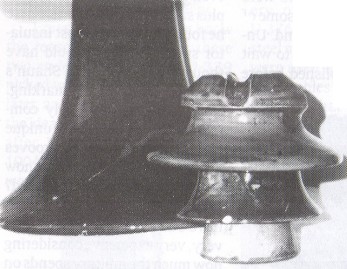 |
 |
|
U-954A with Thomas "blue-jean seam" and very pretty mottled
mustard/orange glaze.
Steve also reported finding a Hewlett suspension disk insulator, which has
the followlng marking:
|
|

|
 |
It must have been made at the time when the insulator logo marking was being
phased out, and the LOCKE marking was first used. He said the LOCKE marking
appears to be branded on the surface, rather than under-glaze ink. I suspect
that the marking was an iron oxide "ink" applied under the glaze. When
the insulator was fired, the iron marking would "burn" though the
glaze, thus giving the appearance that it was branded.
Ken also reported two
other very interesting insulators. The first one is a white U-39 with the incuse marking 'GLEN' on the top. Only
about two of these have been reported before. Ken's insulator was dug in central
New York, which is the same general area that the other specimens were found.
These were made at Fred Locke's factory at Victor, NY, but we do not know the
significance of the marking. If only one specimen had been found, you might
suspect that it was marked with a Victor factory employee's name, but the
marking must have some other meaning.

Fred Locke insulators: U-39, U-39 'GLEN', U-38
Many of you know that Ken Willick lives in Lima, NY, which is the home of the
old Lima Insulator Co. Consequently, Ken is always on the lookout for Lima and
early Pinco insulators. At a local household auction, Ken won the bid on a box of
insulators. In that box, along with the usual common porcelain, was a new
porcelain style, which I have assigned U-133A. Ken graciously sent it to me for close
inspection. I firmly believe that it is an early Lima insulator (1904-1908),
as the glaze is characteristic of that time period. When I first saw this
insulator, I instantly realized that two previously unidentified styles were
most certainly made by Lima, too. These are U-30A and U-133. I first saw these
two styles at the Rochester National, in 1984. I quickly bought a couple of each
thinking that they were Fred Locke insulators; after all, they had nice tan glazes and filed firing rests, just like the
early Victor production. Lima insulators do have similar glazes to those made at
Victor, but the Lima glaze often has a slight purplish cast. After several years
of studying the Lima and Victor glazes, pinhole characteristics and swirl marks
inside the bottom skirt of Lima multiparts, I am convinced that Lima products
can now be determined with a reasonable degree of certainty.
 |
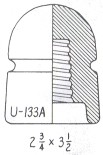 |
U-30A, U-133A, U-133
Unmarked insulators made by Lima Insulator Co.
(1904-1908) |
Fred Collier (NIA #2933) has a couple of interesting reports. The first one
is about two varieties of U-410. which were both made by Pittsburg. In the
photograph below. the insulator on the right matches the U-Chart drawing for U-410. The
insulator on the left is a slightly larger version. Does anyone realize that
U-410 can be found in two sizes? Thanks, Fred, for pointing this out. Either style is rare. so
he is probably the only person to have two of these. The one on the left may be
the rarer of the two.
 |
 |
| U-410 variant (lift) and typical U-410 (right) |
Fred reports a very unusual insulator (see drawing) that
we need some help in identifying. It has a chocolate brown glaze and a standard
threaded pinhole. He says that the insulator "looks incomplete", and
that there is a possibility that it is the top part to a two-part insulator,
since there is some flaking around the pinhole, as if it were screwed down
against another insulator part or electrical equipment. Due to its odd shape,
and since there is no indication that a wire or tie-wire was used in the groove, I suspect that this insulator
was not used in the normal manner as a line wire insulator on a crossarm, but
rather in some special service, such as can be found around a substation or
other such facility. If it were the top part of a two-part insulator, the bottom
half would have to be narrow enough to fit inside the extended skirt of this odd
insulator. We would appreciate any information that you have regarding the
use of this insulator. I am holding off assigning it a U-number, because of the
suspected special service, and the possibility that it is not complete.
 |
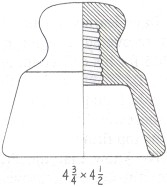 |
Odd (incomplete??) insulator.
Do you know how it was used? |
I received a report a couple of years ago that keeps getting overlooked when
it comes time to write another PIN article. Both Bob Harding (NIA #3746) and
David Wilson (NIA #3630) are credited with this report, but Rob Lloyd (NIA #3414) was in on the find, too.
Bob reported that he and Rob were on an insulator
hunting trip in Columbus, OH when they spotted some downed utility poles at a
bridge reconstruction site. They picked up some nice power glass and a few U-705's. Rob noticed that some of them had an unusual marking. The insulators
have a reddish mahogany glaze with the following "keystone F" marking
deeply incuse marked on the skirt:

Dave learned about the find and recovered another marked U-705 for his
collection. A week later, Dave returned to the site where he found two more U-705's, but these were incuse marked "FP" on the top firing rest.
We
know that the Franklin Porcelain Co. (Norristown, PA) used the "FP"
marking, but it is very uncommon to find a marked specimen. The "keystone F" was surely that of Franklin Porcelain
Co., too, since both marking types were found on the same insulator style, and
at the same location.
Electric Service Supplies Co. was the sole sales agent for
the Franklin Porcelain Co., and they obtained controlling interest in the
company soon after Franklin started business. ESSC used a keystone logo in their
trade journal ads in the mid to late 1920's.
Dave notes that one of the
"FP" marked U-705' s has a squared crown, just like in Jack Tod's U-Chart drawing; however, the other "FP" marked one, and the
"keystone F" marked one, have a more rounded crown detail. Bob Stahr
(NIA #4186) sent me a copy of the following advertisement from a 1927 issue of
"Electrical World". Note that all of the insulators have a squared
crown. In 1927, most insulator manufacturers had already changed their insulator
designs to rounded edges, which reduces the electrical stress around the
insulator (sharp edges provide an arcing point). We might speculate that the
"FP" marked specimens with a rounded crown were made later than the
squared crown specimens (1927 and later), and maybe they were used as
replacements at this location. Since the "keystone F" marked specimens
also have rounded crowns, they may have been made even later, and introduced as
replacements at this site. Since bridges and rivers tend to attract people, and
people like to throw rocks at insulators, this bridge site might have been a
prime location for damaged insulators, and the occasional need for insulator replacements.
Franklin Porcelain Co. went out of business in either 1928 or 1929.

Medium Image (118 Kb)
Large Image (294 Kb)
|
